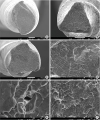1. Parashos P, Messer HH. Rotary NiTi instrument fracture and its consequences. J Endod. 2006; 32:1031–1043.

2. Sattapan B, Nervo GJ, Palamara JE, Messer HH. Defects in rotary nickel-titanium files after clinical use. J Endod. 2000; 26:161–165.

3. Wei X, Ling J, Jiang J, Huang X, Liu L. Modes of failure of ProTaper nickel-titanium rotary instruments after clinical use. J Endod. 2007; 33:276–279.

4. Thompson SA. An overview of nickel-titanium alloys used in dentistry. Int Endod J. 2000; 33:297–310.

5. Cheung GS. Instrument fracture: mechanisms, removal of fragments, and clinical outcomes. Endod Topics. 2007; 16:1–26.

6. Martín B, Zelada G, Varela P, Bahillo JG, Magán F, Ahn S, Rodríguez C. Factors influencing the fracture of nickel-titanium rotary instruments. Int Endod J. 2003; 36:262–266.

7. Pruett JP, Clement DJ, Carnes DL Jr. Cyclic fatigue testing of nickel-titanium endodontic instruments. J Endod. 1997; 23:77–85.

8. Yared GM, Bou Dagher FE, Machtou P. Cyclic fatigue of ProFile rotary instruments after clinical use. Int Endod J. 2000; 33:204–207.

9. Ferreira F, Adeodato C, Barbosa I, Aboud L, Scelza P, Zaccaro Scelza M. Movement kinematics and cyclic fatigue of NiTi rotary instruments: a systematic review. Int Endod J. 2017; 50:143–152.

10. Yared G. Canal preparation using only one Ni-Ti rotary instrument: preliminary observations. Int Endod J. 2008; 41:339–344.

11. Ahn SY, Kim HC, Kim E. Kinematic effects of nickel-titanium instruments with reciprocating or continuous rotation motion: a systematic review of
in vitro studies. J Endod. 2016; 42:1009–1017.

12. You SY, Bae KS, Baek SH, Kum KY, Shon WJ, Lee W. Lifespan of one nickel-titanium rotary file with reciprocating motion in curved root canals. J Endod. 2010; 36:1991–1994.

13. Pedullà E, Grande NM, Plotino G, Gambarini G, Rapisarda E. Influence of continuous or reciprocating motion on cyclic fatigue resistance of 4 different nickel-titanium rotary instruments. J Endod. 2013; 39:258–261.

15. Özyürek T, Yılmaz K, Uslu G. Effect of adaptive motion on cyclic fatigue resistance of a nickel titanium instrument designed for retreatment. Restor Dent Endod. 2017; 42:34–38.

16. Keskin B, Özyürek T, Furuncuoğlu F, İnan U. The effects of adaptive motion on cyclic fatigue resistance of twisted files. J Dent Appl. 2016; 3:337–339.
17. Gambarini G, Rubini AG, Al Sudani D, Gergi R, Culla A, De Angelis F, Di Carlo S, Pompa G, Osta N, Testarelli L. Influence of different angles of reciprocation on the cyclic fatigue of nickel-titanium endodontic instruments. J Endod. 2012; 38:1408–1411.

18. Shin CS, Huang YH, Chi CW, Lin CP. Fatigue life enhancement of NiTi rotary endodontic instruments by progressive reciprocating operation. Int Endod J. 2014; 47:882–888.

19. Arslan H, Alsancak M, Doğanay E, Karataş E, Davut Çapar İ, Ertas H. Cyclic fatigue analysis of Reciproc R25® instruments with different kinematics. Aust Endod J. 2016; 42:22–24.

20. Plotino G, Grande NM, Testarelli L, Gambarini G. Cyclic fatigue of Reciproc and WaveOne reciprocating instruments. Int Endod J. 2012; 45:614–618.

21. da Frota MF, Espir CG, Berbert FL, Marques AA, Sponchiado-Junior EC, Tanomaru-Filho M, Garcia LF, Bonetti-Filho I. Comparison of cyclic fatigue and torsional resistance in reciprocating single-file systems and continuous rotary instrumentation systems. J Oral Sci. 2014; 56:269–275.

22. Scelza P, Harry D, Silva LE, Barbosa IB, Scelza MZ. A comparison of two reciprocating instruments using bending stress and cyclic fatigue tests. Braz Oral Res. 2015; 29:1–7.

23. De-Deus G, Leal Vieira VT, Nogueira da Silva EJ, Lopes H, Elias CN, Moreira EJ. Bending resistance and dynamic and static cyclic fatigue life of Reciproc and WaveOne large instruments. J Endod. 2014; 40:575–579.

24. Higuera O, Plotino G, Tocci L, Carrillo G, Gambarini G, Jaramillo DE. Cyclic fatigue resistance of 3 different nickel-titanium reciprocating instruments in artificial canals. J Endod. 2015; 41:913–915.








 PDF
PDF ePub
ePub Citation
Citation Print
Print



 XML Download
XML Download